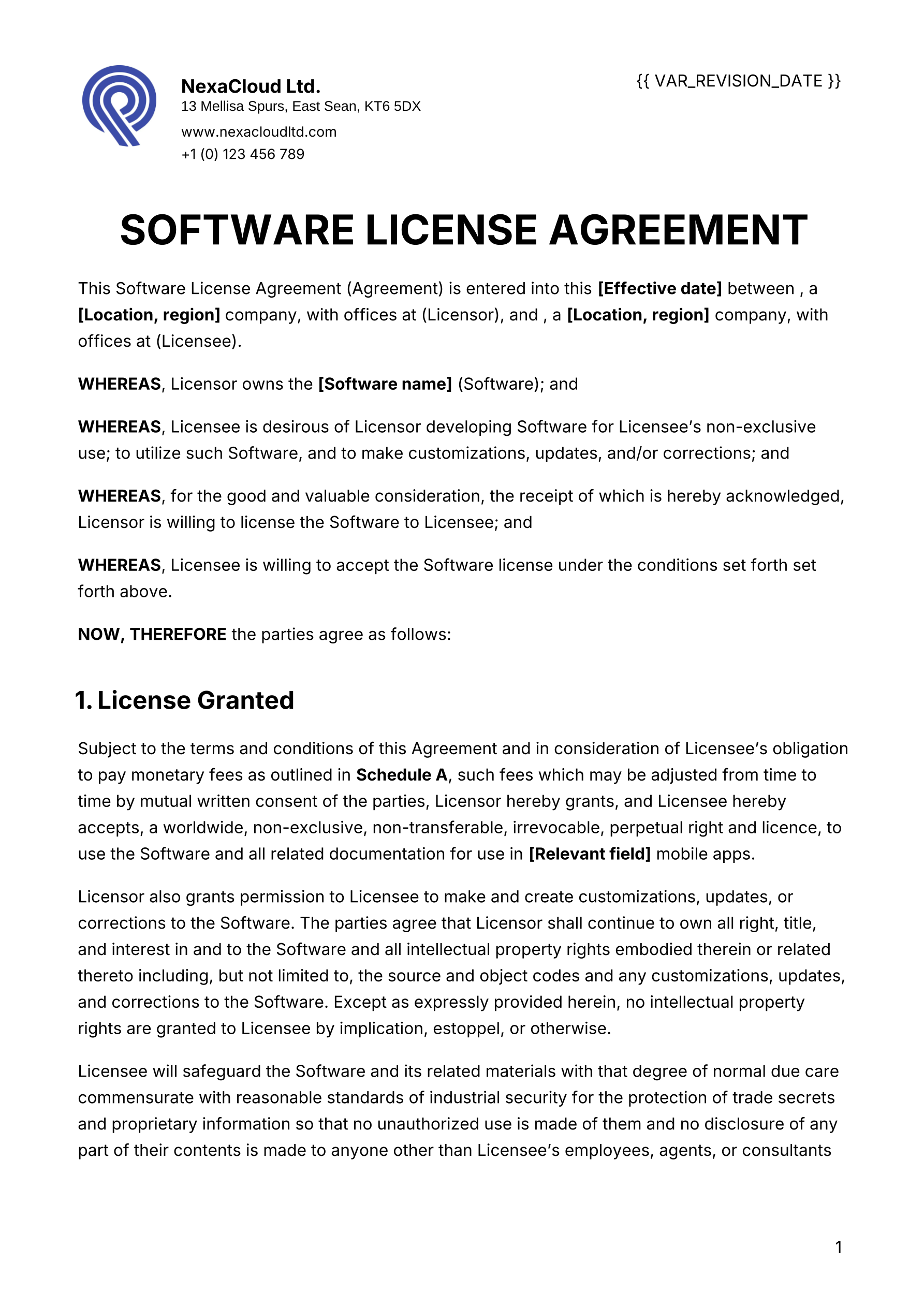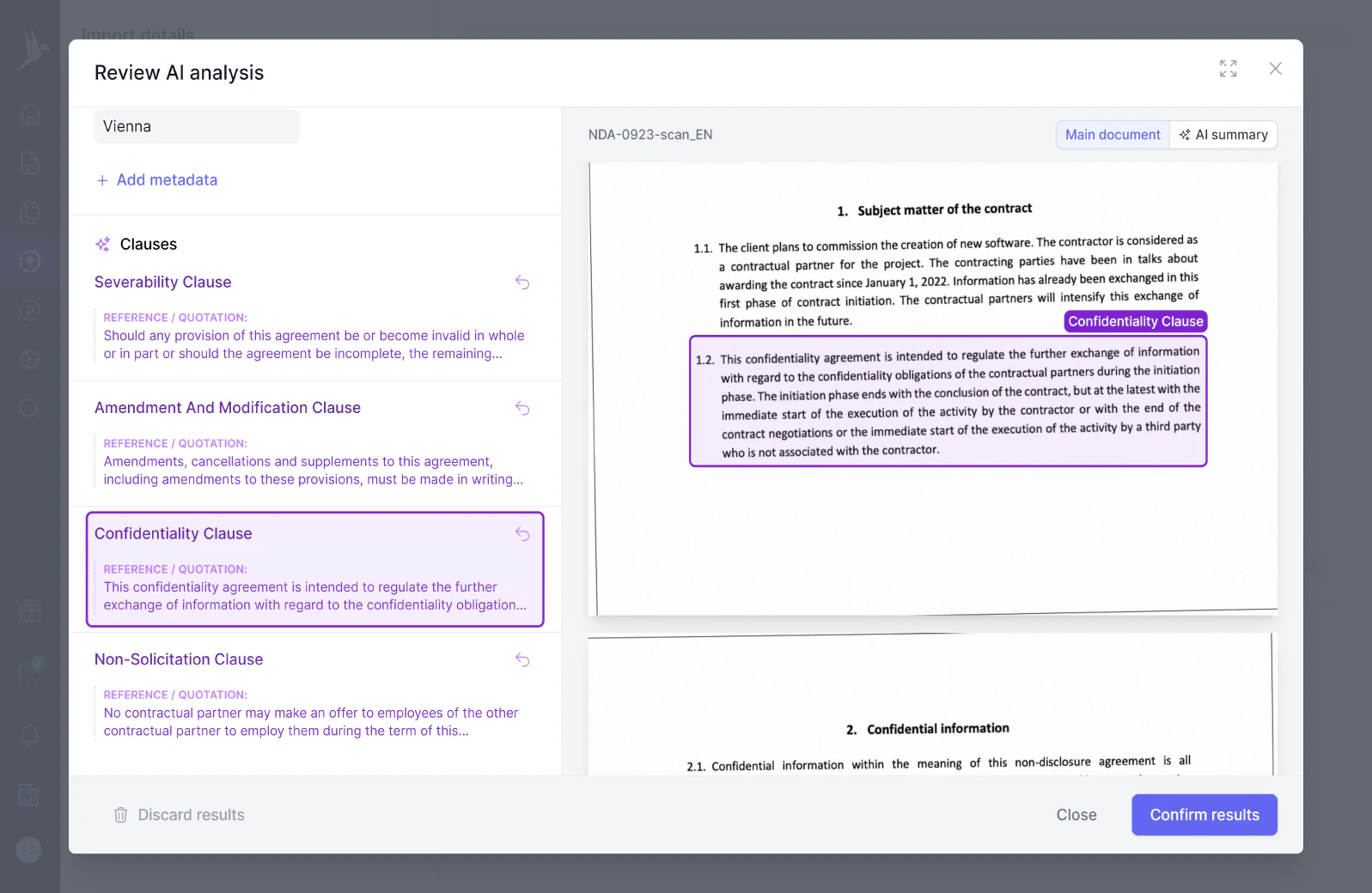
Software License Agreement (SLA) Template
A software license agreement is a contract between the software developer or vendor and the user, outlining the terms and conditions for using the software.
A disclaimer clause is a legal statement included in contracts to limit or waive liability for certain actions or outcomes, protecting the party issuing it from potential claims or losses. Learn what a disclaimer clause is, how it limits liability, and explore practical disclaimer examples used in contracts and services.
Disclaimer: This material contains calculations that may not produce an accurate sum or result due to rounding performed.
Super disclaimer: Guaranteed lifetime income depends upon staying within the parameters of the contract or policy. This is not an offering of any securities for sale in New York.
Super disclaimer: This is not an offering of any securities for sale in New York.
Any disclaimer or other notice that may appear below is not applicable to this communication and should be disregarded. Such disclaimer or notice was automatically generated as a result of this communication being sent by Bloomberg or another email system.
See the http://www.gs.com/disclaimer/afg/ for important information regarding this message and your reliance on information contained in it. This message may contain information that is confidential or privileged. If you are not the intended recipient, please advise the sender immediately and delete this message. See the http://www.gs.com/disclaimer/email/ for further information on confidentiality and the risks inherent in electronic communication.
See http://www.goldmansachs.com/disclaimer/salesandtrading/index.html for risk disclosure, order handling practices, conflicts of interest and other terms and conditions relating to this e-mail and your reliance on it, and http://www.goldmansachs.com/disclaimer/ipo/ for recent prospectuses for initial public offerings to which this message may relate. See http://www.goldmansachs.com/disclosures/swaps-related-disclosures/index.html for important disclosures relating to CFTC-regulated swap transactions. This e-mail may contain confidential or privileged information. If you are not the intended recipient, please advise us immediately and delete it. See http://www.goldmansachs.com/disclaimer/email/ on confidentiality and the risks of electronic communication. If you cannot access these links, please notify us by reply message and we will send the contents to you. This material is a solicitation of derivatives business generally, only for the purposes of, and to the extent it would otherwise be subject to, §§ 1.71 and 23.605 of the U.S. Commodity Exchange Act.
Disclaimer: This material contains calculations that may not produce an accurate sum or result due to rounding performed.
Disclaimer: “This video is for information purposes only. No money or other consideration is being solicited or accepted in connection with the communications made in this video. Offers to buy the securities referenced in this video cannot be accepted, and no part of the purchase price can be received until VictoryBase Corporation’s Form 1-a is qualified, and any offer can be withdrawn or revoked at any time before notice of its acceptance is given after the qualification date. An indication of interest in the securities referenced in this video involves no obligation or commitment of any kind. To obtain a copy of the preliminary offering circular, please contact Thomas Paquin at [email protected].”
Website Disclaimer We have included website addresses in this press release solely as inactive references. The information contained on, or that can be accessed through, such websites is not a part of this press release.
Disclaimer Gartner Peer Insights Customers’ Choice constitute the subjective opinions of individual end-user reviews, ratings, and data applied against a documented methodology; they neither represent the views of, nor constitute an endorsement by, Gartner or its affiliates.
Super disclaimer: Guaranteed lifetime income depends upon staying within the parameters of the contract or policy. This is not an offering of any securities for sale in New York.
Legal Disclaimer: Forward Looking Statement [Links to: wejo.com/forward-looking-statements]
A disclaimer is a statement intended to specify or limit the scope of rights and obligations that may be exercised and enforced by parties in a legally recognized relationship. Disclaimers are commonly used to protect the creator or provider of a product, service, or content from potential legal liabilities arising from its use.
Disclaimers can take many forms and serve various purposes, such as:
You need a disclaimer whenever you share information, offer a service, or sell a product that could potentially expose you or your business to legal liability, misunderstanding, or misuse. Disclaimers help set boundaries, clarify responsibility, and protect you from claims that may arise from how others use or interpret your content, product, or advice.
If you share informational, educational, or advisory content — such as on a blog, website, video, or publication — a disclaimer clarifies that your content should not be taken as professional advice. Examples:
Health or fitness blogs need a medical disclaimer.
Finance or investing sites need a financial disclaimer.
Legal information pages need a legal advice disclaimer.
Businesses include disclaimers to clarify limitations of warranties or risks of use. This helps prevent liability if a product or service doesn’t meet user expectations. Examples:
A software company may include an “as is” disclaimer stating there’s no guarantee the product will be error-free.
A cosmetics brand may state that results vary by individual and that users should test for allergies before use.
If your website or app displays third-party information, links, or user comments, you need a disclaimer stating you’re not responsible for the accuracy or reliability of that content. Example:
News aggregators or forums often include a disclaimer that opinions belong to individual users, not the platform.
If you earn a commission from affiliate links, you are legally required (under FTC rules in many regions) to disclose this relationship through an affiliate disclaimer. Example:
“This post contains affiliate links. I may earn a commission at no extra cost to you.”
Businesses, especially in finance and corporate communications, include forward-looking statement disclaimers to caution readers that future outcomes may differ from expectations. Example:
“Forward-looking statements are based on current expectations and involve risks and uncertainties. Actual results may differ materially.”
Examples of disclaimers with different topics:
Disclaimer: The information provided on this website is for general informational purposes only. All information is provided in good faith; however, we make no representation or warranty of any kind regarding the accuracy, adequacy, validity, reliability, or completeness of any information on the site.
Medical Disclaimer: This website does not provide medical advice. The information, including text, graphics, and other material, is for informational purposes only and is not a substitute for professional medical advice, diagnosis, or treatment. Always seek the advice of your physician or another qualified healthcare provider regarding any medical condition.
Financial Disclaimer: All investment strategies and investments involve risk of loss. Nothing contained in this document should be construed as investment advice. You should consult with a qualified financial advisor before making any financial decisions.
Legal Disclaimer: The information contained on this website is provided for general informational purposes only and does not constitute legal advice. No attorney-client relationship is formed by reading or using this information. You should contact a qualified attorney for advice regarding your specific situation.
Affiliate Disclaimer: Some of the links on this website are affiliate links, which means we may earn a small commission if you make a purchase through them, at no additional cost to you. We only recommend products or services that we believe will add value to our readers.
Writing an effective disclaimer involves clearly identifying the potential liabilities you want to avoid and specifying the limitations or warnings related to your product, service, or content. Here are some general steps to follow:
Identify the Purpose: Clearly determine the primary reason for your disclaimer, whether it’s to limit liability, provide guidance, or establish terms of use.
Be Specific and Clear: Avoid ambiguous language. Clearly outline what you are disclaiming responsibility for and detail the scope of limitations or conditions.
Use Plain Language: Ensure the disclaimer is easily understood by your audience, avoiding legal jargon whenever possible.
Tailor to Your Needs: Customize your disclaimer to fit the specific context of your product, service, or content. Generic disclaimers may not adequately protect you.
Review Legal Requirements: Understand legal obligations related to your industry or jurisdiction to ensure your disclaimer meets any necessary legal standards.
| Type of Disclaimer | Purpose | Common Use Cases | Sample Clause |
|---|---|---|---|
| Liability Disclaimer | Limits the responsibility of the provider for losses or damages incurred through use of a product or service. | Websites, services, software, consulting | “We shall not be held liable for any damages arising out of or in connection with the use of this website.” |
| Warranty Disclaimer | States that the product or service is provided “as is,” with no guarantees of quality, performance, or fitness for purpose. | Product manuals, software EULAs, online services | “This product is provided ‘as is’ without any express or implied warranty of any kind.” |
| Damage Disclaimer | Disclaims responsibility for damages, especially indirect or consequential damages. | Equipment rentals, software, construction agreements | “The company is not liable for any direct, indirect, or consequential damages resulting from use of this equipment.” |
| Tax Disclaimer | States that the information provided does not constitute tax advice and should not be relied upon. | Financial blogs, consulting, e-commerce | “This material is for informational purposes only and should not be considered tax advice. Consult a qualified tax advisor.” |
| Medical Disclaimer | Disclaims responsibility for the misuse or misinterpretation of health-related information. | Health blogs, wellness apps, supplements | “The information provided is not intended as a substitute for professional medical advice, diagnosis, or treatment.” |
| Legal Disclaimer | Clarifies that the content does not constitute legal advice. | Law firm blogs, forums, legal info platforms | “This content is for informational purposes only and does not constitute legal advice.” |
| Financial Disclaimer | Disclaims liability for financial decisions based on the content provided. | Investment blogs, fintech apps, advisory services | “The information provided does not constitute financial advice. Investment decisions should be based on your personal circumstances.” |
| Views Expressed Disclaimer | Clarifies that opinions are those of the author and not their employer or affiliated institution. | Blogs, podcasts, academic articles | “The views expressed here are solely those of the author and do not necessarily reflect the views of their employer.” |
| Third-party Content Disclaimer | Disclaims responsibility for the content of external sites linked or referenced. | Websites, newsletters, apps | “We are not responsible for the content or accuracy of any external websites linked from this site.” |
Disclaimers are included in various types of contracts and agreements to protect against liability and clarify responsibilities. Common contracts containing disclaimers include:
By understanding and appropriately implementing disclaimers, businesses and individuals can better manage legal risks and clearly communicate terms to their audiences.
These templates contain the clause you just read about.

A software license agreement is a contract between the software developer or vendor and the user, outlining the terms and conditions for using the software.
Dive deeper into the world of clauses and learn more about these other clauses that are used in real contracts.
A disclosure letter is a document provided during a transaction, typically accompanying a sale agreement, where the seller discloses specific information and any exceptions to the warranties stated in the contract. It serves to clarify details and protect the seller against potential future claims by informing the buyer of actual circumstances that might differ from contractual assumptions.
A disclosure statement is a clause within a contract that requires one party to provide certain information or documents to the other party, ensuring transparency and informed decision-making. This clause is crucial for preventing misunderstandings and potential disputes by clearly outlining the nature and extent of information to be disclosed.
Dispositive power refers to the authority granted to an individual or entity to manage, direct, or dispose of assets or interests, typically within the context of a trust or investment arrangement. This power can include the ability to buy, sell, transfer, or otherwise regulate the assets, and is often accompanied by fiduciary responsibilities to act in the best interests of the beneficiaries or stakeholders.
Try our AI contract analysis and extract important clauses and information from existing contracts.
< <
Fill out the form and we will get in touch with you to give you a personal, customized demo of fynk.
Greetings!
I'm Markus, co-founder of fynk. After you've submitted the form, I'll swiftly get in touch with you.
Also, right after you submit your details, you can pick a time that works best for you for our meeting.

